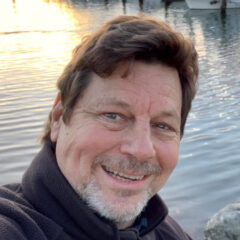(RNS) — If you grew up Pentecostal or evangelical Christian — as I did — you probably remember the prophecy sermons and apocalyptic charts about the Last Days. Preachers warned about the Great Tribulation, the rise of the Antichrist and the “mark of the Beast.” In the 1970s and ’80s, movies, most memorably “A Thief in the Night” and the Left Behind series, dramatized wars, plagues, secret police and global control. Terrifying as they were, such depictions also offered a strange comfort: the idea that the faithful few might escape it all.
By the turn of the millennium, many of us had put away that style of end-times speculation. The Cold War was over, the prophecy books faded and “Antichrist” began to sound like a rapture relic of the past. I thought I had outgrown that language for good — until it resurfaced in Silicon Valley.
In recent days, billionaire investor Peter Thiel, a co-founder of PayPal, early backer of Facebook and founder of Palantir, the surveillance company used by U.S. defense and intelligence agencies, launched a private lecture series on “the Antichrist” for technologists and futurists. Hosted by the ACTS 17 Collective at the Commonwealth Club in San Francisco, the talks won’t be recorded or published. But based on Thiel’s public writings and past interviews, we know something about how he envisions the collapse of civilization.
Thiel seems to see the apocalypse unfolding in stages. He interprets the Antichrist not as a single figure but as a global, technological, authoritarian system — one that secures peace and stability at the cost of freedom and democracy. In his view, the danger lies not in our society’s overt defiance of religion, but in the co-opting of its language and symbols: promises of “law and order,” “peace and safety” that mask the rise of centralized control.
Drawing on biblical imagery, Thiel links this Antichrist system to the visions found in the New Testament’s Book of Revelation and its warnings of false messiahs and counterfeit peace. A lone tyrant is less likely to succeed in leveraging fear — of war, pandemics or economic collapse — to justify total control, but in Thiel’s view: a centralized autocracy may well. Such a system, he argues, can cloak itself in morality or even “hyper-Christian” rhetoric, promising salvation while enslaving humanity.
The alternative to the Antichrist system, Thiel argues, is “Armageddon” — the catastrophic collapse of civilization through global warfare and destruction. For him, our world is trapped between two extreme possibilities: annihilation or authoritarianism. The fear of collapse makes societies more willing to embrace authoritarian solutions that promise safety at any cost.
The only possible balance, Thiel suggests, lies in what the apostle Paul described in the New Testament’s Second Letter to the Thessalonians as the katechon — a mysterious “restraining force” that holds back the spirit of the Antichrist. As a theologian, I find it significant that Thiel turns to one of Paul’s most cryptic passages to frame his political imagination: Paul never explains what the restraining force is, leaving it open to interpretation. Thiel’s reading reveals less about Paul and more about how Silicon Valley elites are reinterpreting apocalyptic language for their own purposes.
What happens when this restraining force is removed? Thiel imagines that the Antichrist system collapses into Armageddon. Only the few survive. A techno-libertarian, he entertains a kind of secular rapture: off-grid bunkers, floating cities or even planetary colonies. In his apocalyptic vision, these survivalist escape hatches offer a way out of both collapse and tyranny — but only for the wealthy and well-prepared.
His own record makes the contradictions sharper. Thiel was an early supporter of Donald Trump, a financier of J.D. Vance and a chief supplier of government surveillance through Palantir. With a net worth of over $20 billion, he has reportedly secured his own survival on a 477-acre compound in New Zealand. For the rest of us, the stakes go far beyond Silicon Valley.
Thiel, in other words, is no fringe preacher, but one of the most influential technocrats alive, warning against authoritarian systems while also profiting from the technologies, political networks and surveillance tools that could enable them. A self-described libertarian, he moves fluidly in the nexus of technocracy, theology, right-wing politics and Christian nationalism.
This raises the unsettling question: Is Thiel exposing the Antichrist, or announcing it?
Perhaps a more vital question for us, given the multitude of “existential threats” on the horizon, caught in a dilemma between annihilation (“Armageddon”) and authoritarian control (“Antichrist”), is how shall we choose to live?
The challenge for people of faith, conscience and goodwill is not to succumb to fear or forecast doomsday, but to practice discernment and cultivate community. The spiritual advice I once heard in church may still be the best guide today: read the signs, take heart, stay vigilant, speak truth, do good work, persevere and love your neighbor.
The apocalypse may not arrive suddenly in the form of beasts and battles. More likely, it will look like an ongoing negotiation between collapse and control. Our task is to see things clearly, name the powers and resist both extremes.

But resistance alone is not enough. Against the survivalist fantasies of bunkers and colonies, real resilience is found in solidarity and community — becoming good neighbors, offering refuge to outsiders and building networks of solidarity and trust that can withstand fear-driven authoritarianism and collapse. If there is an escape hatch, it is not a private rapture but collective faith and action.
(The Rev. Michael J. Christensen is a theologian, church historian and author of “City Streets, City People,” “The Samaritan’s Imperative” and “C.S. Lewis on Scripture.” The views expressed in this commentary do not necessarily reflect those of Religion News Service.)
Original Source: